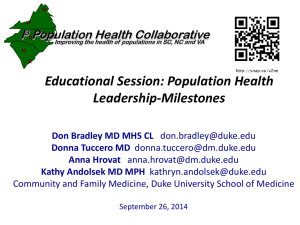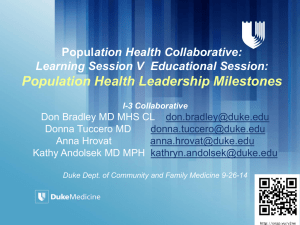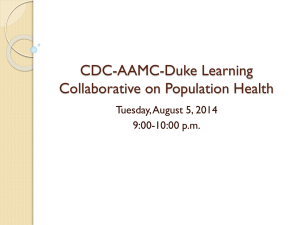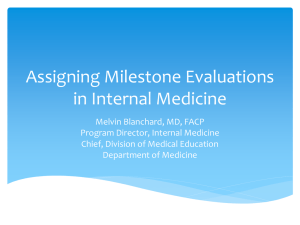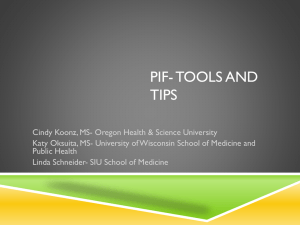Powerpoint Slides - Population Health Resources
advertisement
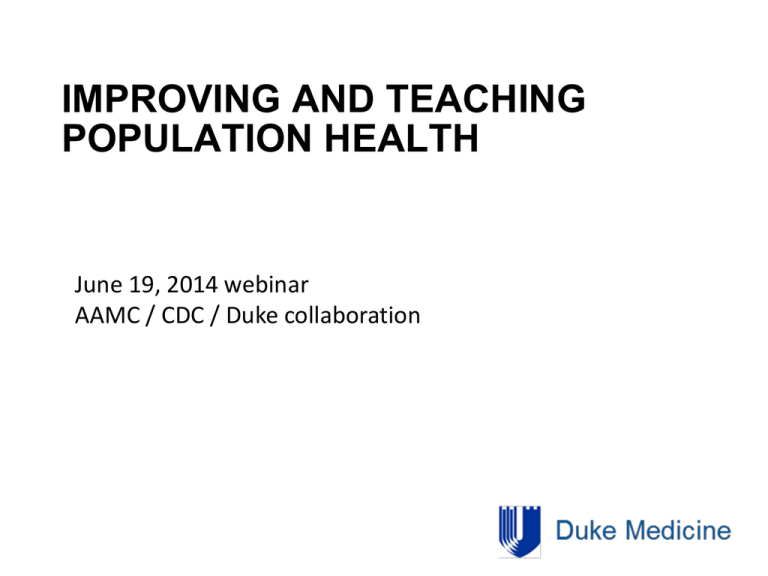
IMPROVING AND TEACHING POPULATION HEALTH June 19, 2014 webinar AAMC / CDC / Duke collaboration J. Lloyd Michener, MD Professor and Chair Department of Community and Family Medicine Director, Duke Center for Community Research Mina Silberberg, Ph.D. Associate Professor Vice-Chief for Research and Evaluation Division of Community Health Alisa Nagler, JD, EdD Assistant Dean, Graduate Medical Education Assistant Professor, Practice of Medical Education Gwen Murphy, RD, MS, PhD Assistant Consulting Professor Division of Community Health Department of Community and Family Medicine Population Health: the health outcomes of a group of individuals, including the distribution of such outcomes within the group. Source: Kindig D, Stoddart G. What is Population Health? Am J of Public Health. 2003; 93(3): 380-383. The Goal: “from Health Care to Health” IMPROVING POPULATION HEALTH – In one sentence: Know the burden of preventable illness in your community, and partner with community practices and agencies to prevent these illnesses Disease Burden / Practice Patterns Vary Source: The Quality of Medical Care in the United States: A Report on the Medicare Program. The Dartmouth Atlas of Health Care 1999. The Center for the Evaluative Clinical Sciences Dartmouth Medical School Change In Female Mortality Rates From 1992–96 To 2002–06 In US Counties. Kindig D A , and Cheng E R Health Aff 2013;32:451-458 ©2013 by Project HOPE - The People-to-People Health Foundation, Inc. Durham residents with diabetes (2007-2009) 14,345 unique patients 8.7% of all patients >20 yo 14.3% of all patients >40 yo Durham County Stats (per CDC): 2008 ~ 10% of adults diagnosed with diabetes North Carolina (CDC): 2008 ~ 9% of adults diagnosed with diabetes By Race: 8.4% White 15.6% AA 12.4% NA 4.5% Hispanic 4.3% Other www.iom.edu/primarycarepublichealth Degrees of Integration: What is integration? The Institute of Medicine defines integration as ‘the linkage of programs and activities to promote overall efficiency and effectiveness and to achieve gains in population health.’ Principles of Integration: Shared goal of population health Aligned leadership Community engagement Sustainability Collaborative use of data Why integrate now? • Call to Action – IOM Report – Affordable Care Act – New Funding Opportunities • Changes in Health Care – – – – – – Rise in Health Care Costs Disturbing Health Trends Increase in Health Research and Data Impact of Social Determinants of Health Drive to PCMHs and ACOs Availability of Electronic Health Records What can integration do? Just For Us Just For Us Percent Difference Between Medicaid Recipients Enrolled in CCNC and Those Not Enrolled in CCNC, for Rates of Asthma-Related Emergency Department Visits and Inpatient Admissions, 2008–2012 Note. CCNC, Community Care of North Carolina. NCMJ September/October 2013, Volume 74, Number 5 What is the Practical Playbook? A cornerstone of the next transformation of health, in which primary care and public health groups work collaboratively to achieve population health improvement. www.practicalplaybook.org National Advisory Committee American Academy of Family Physicians Centers for Medicare & Medicaid Services American Academy of Pediatrics Council of State and Territorial Epidemiologists American Association of Colleges of Osteopathic Medicine Eastern Virginia Medical School American Board of Family Medicine Geisinger Health System American College of Physicians Health Resources and Services Administration American College of Preventive Medicine Kaiser Permanente American Heart Association Los Angeles County Health Department Association of Academic Health Centers Multnomah County Health Department, Oregon Association of American Medical Colleges New York City Health Department Association of Public Health Nurses Pennsylvania Health Department Association of State and Territorial Health Officials University of California San Francisco Centers for Disease Control & Prevention University of Utah Practical Playbook Overview Massachusetts Improves Quality of Life for Children with Asthma The Community Asthma Initiative works to improve the health and quality of life for children with asthma. Boston Children’s Hospital designed the program to focus on medical interventions rather than environmental influences. Since its establishment, the program has worked in tandem with partners at every level, including the individual, family, and larger community. As a result, the Community Asthma Initiative helped reduce the percent of emergency department visits by 58 percent, the number of asthma-related hospitalizations, CAI helped reduce the number of the number of school absences for children, and the asthma-related hospitalizations number of work absences for their parents. by 80 percent. Maryland Prevents One Million Heart Attacks and Strokes The Maryland Million Hearts Initiative is part of a national campaign to prevent one million heart attacks and strokes by 2017. The statewide initiative is a partnership between the Department of Health and Mental Hygiene and local communities, health systems, nonprofit organizations, federal agencies and private-sector businesses. Since the program began, the state has seen an increase in blood pressure control at participating centers. The program has seen a 27 percent increase in blood pressure control at participating centers. Next steps – define what clinicians need to know and do in and with the community The Population Health Competency Map Training Levels: 1. Foundational — Basic awareness of the principles and appreciation for their impact and importance in community health. 2. Applied — An intermediate level of learning, enabling skilled participation in community-engaged population health activities. 3. Proficient — Advanced learners who achieve competence for independent practice or leadership of the design and implementation of community-engaged health improvement activities. Competencies • • • • Public Health Community Engagement Critical Thinking Team Skills Competency Map: Integrating Population Health into Clinician Education Learners: Competency: Public Health Community Engagement Critical Thinking Team Skills medical PA, FM PT students residents F F F F F = Foundational (Basic) Awareness A = Applied (Intermediate) Skilled participation P = Proficient (Advanced) Independent practice nurse leaders FM faculty P P P P Population Health Curriculum Training levels Basic Intermediate Advanced Learner types • • • • All students & residents Primary care residents CFM faculty • Apply strategies that improve the health of populations • Discuss potential • Identify populationappropriate based preventive interventions to strategies for a improve health population, based upon literature, data assessment and stakeholder input Learning Method • Project: design an intervention Evaluation • Assess intervention Population Health Fellows & Faculty CH faculty Develop and implement populationbased prevention strategies in collaboration with community partners CDC/AAMC/Duke Project on Population Heath • Convene primary care programs that are interested in improving population health training of residents. • Identify training materials that are already available for medical students and residents, and develop a library of resources. • Map training materials to the GME milestones using current GME population health milestones and program requirements for primary care. IMPROVING AND TEACHING POPULATION HEALTH… Mina Silberberg, Ph.D. Associate Professor Vice-Chief for Research and Evaluation Division of Community Health • Readings or electronic modules followed by small group discussions or group exercises • Community site visits • Community health education • Participation in local Healthy Carolinians coalition • Integrated psychosocial/clinical patient assessment • Projects –QI, community engagement, written and oral reports • Participation in population health management innovations • Work with data • Shadowing care managers Population Health Curriculum evaluation methods • • • • • Discussion participation Project completion Final assessment Post-graduation activity Real test – health improvement in home communities Population Health Curriculum – Faculty Development Population Health Curriculum The result: Clinicians who can care for their patients in the context of their communities IMPROVING AND TEACHING POPULATION HEALTH… Alisa Nagler, JD, EdD Assistant Dean, Graduate Medical Education Assistant Professor, Practice of Medical Education ACGME Milestones • • Component of Next Accreditation System Organized under 6 domains of clinical competency 1. Patient Care 2. Medical Knowledge 3. Professionalism 4. Interpersonal Communication Skills 5. Systems Based Practice 6. Practice Based Learning • Provide framework and shared language to describe learner expectations and progress • Population Health Milestones?? ACGME Milestones Example 1. Review of published milestones for population health related content 2. Development of generic Population Health Milestones for GME Program adoption 3. Linking of existing resources to Population Health Milestones to support Programs with teaching and evaluation ACGME Milestones General Competency Sub-competency Example Developmental Progression not linked to training level “Aspiration” or last level may NOT be achieved by graduating residents OR faculty! Mid-range evaluation indicates trainee has met some but NOT all of the expectations of the more advanced Milestone Milestone Documentation of evaluation of resident performance ACGME Clinical Learning Environment (CLER) Review • Component of Next Accreditation System • 6 focus areas: 1. 2. 3. 4. 5. 6. Patient Safety Quality Improvement Transitions of Care Supervision Duty Hours Oversight, Fatigue Management & Mitigation Professionalism ACGME Clinical Learning Environment (CLER) Review Component of Next Accreditation System 6 focus areas: 1. 2. 3. 4. 5. 6. “Including how sponsoring institutions engage residents in the use of data to improve systems of care, reduce health care disparities and improve patient outcomes.” Patient Safety Quality Improvement http://acgme.org/acgmeweb/tabid/436/ProgramandInstitutionalAc Transitions of Care creditation/NextAccreditationSystem/ClinicalLearningEnvironmentR eviewProgram.aspx Supervision Duty Hours Oversight, Fatigue Management & Mitigation Professionalism BACK TO LLOYD FOR FINAL HOUSEKEEPING ITEMS Next steps: 1) Share contact info 2) Volunteers for institutional presentations 3) Program evaluation 4) Other? Email address: Gwen.murphy@duke.edu Resources - Department of Community and Family Medicine webinar and slides posted here: http://cfm.mc.duke.edu/modules/cfm_resrc/index.php?id=1 Milestones webinar schedule repeated June 3rd Tuesday 2:30pm EST June 19th Thursday 3:30pm EST repeated July 1st Tuesday 10am EST July 15th Tuesday 9am EST repeated August 5th Tuesday 9am EST August 12th Tuesday 9am EST repeated September 9th Tuesday 10am EST September 16th Tuesday 3pm EST repeated October 8th Wednesday 3pm EST October 14th Tuesday 9am EST AAMC-CDC Cooperative Agreement Webinar Series To promote increased public health awareness and encourage inclusion of public health perspectives throughout the AAMC community Inclusion and Integration of Population Health into Undergraduate Medical Curriculum June 26, 2014, 1:00 p.m. - 2:00 p.m. ET https://www.aamc.org/initiatives/diversity/portfolios/ cdc/362178/webinarseries.html

